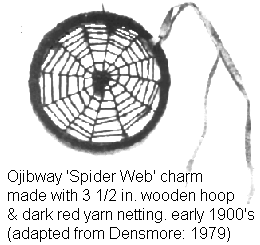Native American Technology and Art
Willow Branches and Other Twigs and Roots.
The Native American technological use of all types of trees and wood is
would fill a million libraries. The Native Americans discovered the
specific qualities of branches, twigs and tree roots that make them
perfectly suited for particular tasks. Native Americans have a
multitude of uses for willow that included medicine and technology.
Native Americans also found utility in the roots and twigs of a
variety of spruces, cedars and pines.
Willow
trees are sturdy, well anchored trees growing along river banks
or near streams, lakes and ponds. Native Americans recognized
 many useful medicinal and technological qualities of the willow
tree. The inner bark and leaves of many willows contains the
medicinal extract, salicin, or salicylic acid (salix is Latin
for willow). This chemical is the active ingredient in common
aspirin. (acetylsalicylic acid). Native Americans chewed or boiled
a tea from the willow's leaves or inner bark to relieve fever
or other minor pain like toothaches, headaches, or arthritis.
The willow is often given the nickname "toothache tree".
many useful medicinal and technological qualities of the willow
tree. The inner bark and leaves of many willows contains the
medicinal extract, salicin, or salicylic acid (salix is Latin
for willow). This chemical is the active ingredient in common
aspirin. (acetylsalicylic acid). Native Americans chewed or boiled
a tea from the willow's leaves or inner bark to relieve fever
or other minor pain like toothaches, headaches, or arthritis.
The willow is often given the nickname "toothache tree".
Aside from medicine, Native Americans developed many technological
applications for willow. Willow branches are straight, pliable
and flexible. Because of these sturdy qualities, the branches
provide excellent an excellent raw material for making a multitude
of items. Many Native American groups used willow to make their
arrow shafts. Drawing or painting by Native Americans sometimes
used a brush made by bruising the end of a willow twig. Native
Americans have produced several kinds 'wicker' basketry (checker-weave
and twined) that uses willow stems or branches. Willow has also
been used by Peoples such as the Kiowa and Blackfoot to make
 backrests with parallel branches bound together with sinew threads
and hung from a tripod. The Arapaho people made a veritable bed
by attaching a willow backrest to a platform raised a foot off
the ground. Willow branches were laid parallel, bent and lashed
together to fashion cradleboards by the Apache. Ojibway traditionally
used willow hoops to make dream catchers for children's cradleboards,
and split willow withes to make dolls. The most amusing application
of split willow branches is probably the construction of these
stick figures, including the prehistoric willow deer from the
Southwest. The Blackfoot people's Brave Society, makes ceremonial
use of this branch; the 'willow brave' (who ranks next to the
leader of the society) carries a branch of willow to which yellow
painted plumes are tied. Dome-shaped wigwams and ceremonial lodges
often incorporate willow saplings for the curving lodge poles.
For some ceremonies and meetings, Natives of the Plains place
a canopy of willow branches on top of the dance arbor; when the
branches are harvested, red willow (Red Osier Dogwood inner bark)
tobacco is offered to each plant to honor its gift.
backrests with parallel branches bound together with sinew threads
and hung from a tripod. The Arapaho people made a veritable bed
by attaching a willow backrest to a platform raised a foot off
the ground. Willow branches were laid parallel, bent and lashed
together to fashion cradleboards by the Apache. Ojibway traditionally
used willow hoops to make dream catchers for children's cradleboards,
and split willow withes to make dolls. The most amusing application
of split willow branches is probably the construction of these
stick figures, including the prehistoric willow deer from the
Southwest. The Blackfoot people's Brave Society, makes ceremonial
use of this branch; the 'willow brave' (who ranks next to the
leader of the society) carries a branch of willow to which yellow
painted plumes are tied. Dome-shaped wigwams and ceremonial lodges
often incorporate willow saplings for the curving lodge poles.
For some ceremonies and meetings, Natives of the Plains place
a canopy of willow branches on top of the dance arbor; when the
branches are harvested, red willow (Red Osier Dogwood inner bark)
tobacco is offered to each plant to honor its gift.
Learn about other Roots and Twigs used by Native Americans:
Spruce
Cedar
Pine
tamarack
Branches, Twigs & Roots Bibliography and Books to Buy On-Line
Return to NativeTech's Branches, Twigs & Roots Menu

© 1994-2000 Tara Prindle.
 many useful medicinal and technological qualities of the willow
tree. The inner bark and leaves of many willows contains the
medicinal extract, salicin, or salicylic acid (salix is Latin
for willow). This chemical is the active ingredient in common
aspirin. (acetylsalicylic acid). Native Americans chewed or boiled
a tea from the willow's leaves or inner bark to relieve fever
or other minor pain like toothaches, headaches, or arthritis.
The willow is often given the nickname "toothache tree".
many useful medicinal and technological qualities of the willow
tree. The inner bark and leaves of many willows contains the
medicinal extract, salicin, or salicylic acid (salix is Latin
for willow). This chemical is the active ingredient in common
aspirin. (acetylsalicylic acid). Native Americans chewed or boiled
a tea from the willow's leaves or inner bark to relieve fever
or other minor pain like toothaches, headaches, or arthritis.
The willow is often given the nickname "toothache tree".
 backrests with parallel branches bound together with sinew threads
and hung from a tripod. The Arapaho people made a veritable bed
by attaching a willow backrest to a platform raised a foot off
the ground. Willow branches were laid parallel, bent and lashed
together to fashion cradleboards by the Apache. Ojibway traditionally
used willow hoops to make dream catchers for children's cradleboards,
and split willow withes to make dolls. The most amusing application
of split willow branches is probably the construction of these
stick figures, including the prehistoric willow deer from the
Southwest. The Blackfoot people's Brave Society, makes ceremonial
use of this branch; the 'willow brave' (who ranks next to the
leader of the society) carries a branch of willow to which yellow
painted plumes are tied. Dome-shaped wigwams and ceremonial lodges
often incorporate willow saplings for the curving lodge poles.
For some ceremonies and meetings, Natives of the Plains place
a canopy of willow branches on top of the dance arbor; when the
branches are harvested, red willow (Red Osier Dogwood inner bark)
tobacco is offered to each plant to honor its gift.
backrests with parallel branches bound together with sinew threads
and hung from a tripod. The Arapaho people made a veritable bed
by attaching a willow backrest to a platform raised a foot off
the ground. Willow branches were laid parallel, bent and lashed
together to fashion cradleboards by the Apache. Ojibway traditionally
used willow hoops to make dream catchers for children's cradleboards,
and split willow withes to make dolls. The most amusing application
of split willow branches is probably the construction of these
stick figures, including the prehistoric willow deer from the
Southwest. The Blackfoot people's Brave Society, makes ceremonial
use of this branch; the 'willow brave' (who ranks next to the
leader of the society) carries a branch of willow to which yellow
painted plumes are tied. Dome-shaped wigwams and ceremonial lodges
often incorporate willow saplings for the curving lodge poles.
For some ceremonies and meetings, Natives of the Plains place
a canopy of willow branches on top of the dance arbor; when the
branches are harvested, red willow (Red Osier Dogwood inner bark)
tobacco is offered to each plant to honor its gift.
